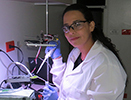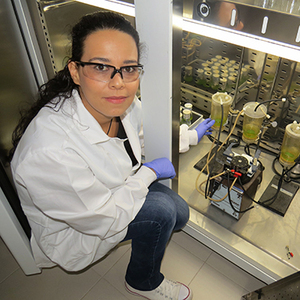Algae cultivation technique could advance biofuels







Washington State University
August 17, 2017
BY Tina Hilding, Voiland College of Engineering
Washington State University researchers have developed a way to grow algae more efficiently—in days instead of weeks—and make the algae more viable for several industries, including biofuels.
Their work was reported in the journal Algal Research.
Environmental benefits
Researchers would like to produce algae efficiently because of its potential environmental benefits. Oil from the algae can be used as a petroleum alternative and algae also can be used as food, feed, fiber, fertilizer, pigments and pharmaceuticals. Growing and harvesting it in wastewater streams could also reduce the environmental footprint of many manufacturing processes.
But its use in industry hasn’t caught on primarily because it requires a lot of time and water to grow. Generally, large ponds are required, and harvesting is labor intensive. Researchers have begun developing biofilm reactors to grow the algae, but the reactors aren’t efficient because of pH or temperature variations or a limited supply of carbon dioxide gas.
Advertisement
Biofilm reactor
Led by graduate student Sandra Rincon and her advisor, Haluk Beyenal, professor in the Gene and Linda Voiland School of Chemical Engineering and Bioengineering, the researchers developed a unique biofilm reactor that recycles gasses and uses less water and lower light than typical reactors.
The algae produced was full of the fats that make it suitable for biodiesel production and “fatter” than other biofilm reactors have produced. Because of a removable membrane, it was also easier to harvest than typical systems.
The system is unique because it allows the algae to simultaneously do photosynthesis like a plant while also “eating” carbon and respiring like an animal, said Beyenal. The researchers fed the algae glycerol, a cheap waste product of biodiesel production, and urea, another inexpensive chemical that serves as a nitrogen source for the algae. The system’s design means that carbon dioxide and oxygen are recycled in the system.
“The cell, in fact, becomes a very efficient factory in which the nutrients are supplied by the medium, but the cell metabolism meets its carbon dioxide requirements internally,” said Rincon.
Advertisement
Patent application filed
Like many new research efforts, the project was challenging, said Beyenal. He credits Rincon with her sustained efforts in spite of several setbacks that might have led others to quit and give up on the work.
“The idea is new,” said Beyenal. “Sandra demonstrated that it worked at the lab scale.”
The researchers have filed a patent application on the technology and are working to optimize the process. Funded through a Fulbright fellowship, the research is in keeping with WSU’s Grand Challenges, a suite of research initiatives aimed at large societal issues. It is particularly relevant to the challenge of meeting energy needs while protecting the environment.
Related Stories
The U.S. Department of Energy Bioenergy Technologies Office (BETO) announced up to $23 million in funding to support research and development (R&D) of domestic chemicals and fuels from biomass and waste resources.
The U.S. DOE has announced its intent to issue funding to support high-impact research and development (R&D) projects in two priority areas: sustainable propane and renewable chemicals and algal system cultivation and preprocessing.
Sens. Sherrod Brown, D-Ohio, and Pete Ricketts, R-Neb., in August introduced the Renewable Chemicals Act, a bill that aims to create a tax credit to support the production of biobased chemicals.
The Chemical Catalysis for Bioenergy Consortium, a consortium of the U.S. DOE’s Bioenergy Technologies Office, has launched an effort that aims to gather community input on the development of new biomass processing facilities.
USDA on March 8 celebrated the second annual National Biobased Products Day, a celebration to raise public awareness of biobased products, their benefits and their contributions to the U.S. economy and rural communities.
Upcoming Events










